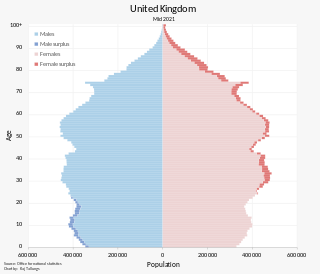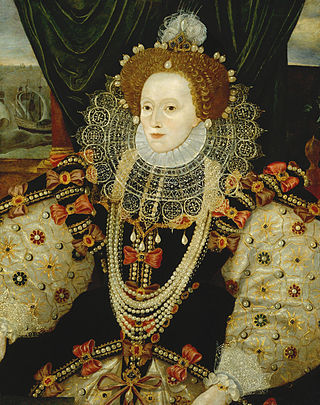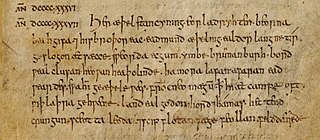Related Research Articles

Daniel Defoe was an English novelist, journalist, merchant, pamphleteer and spy. He is most famous for his novel Robinson Crusoe, published in 1719, which is claimed to be second only to the Bible in its number of translations. He has been seen as one of the earliest proponents of the English novel, and helped to popularise the form in Britain with others such as Aphra Behn and Samuel Richardson. Defoe wrote many political tracts, was often in trouble with the authorities, and spent a period in prison. Intellectuals and political leaders paid attention to his fresh ideas and sometimes consulted him.

The population of the United Kingdom was estimated at over 67.0 million in 2020. It is the 21st most populated country in the world and has a population density of 270 people per square kilometre, with England having significantly greater density than Wales, Scotland, and Northern Ireland. Almost a third of the population lives in south east England, which is predominantly urban and suburban, with about 9 million in the capital city, London, whose population density is just over 5,200 per square kilometre.

The Elizabethan era is the epoch in the Tudor period of the history of England during the reign of Queen Elizabeth I (1558–1603). Historians often depict it as the golden age in English history. The symbol of Britannia was first used in 1572, and often thereafter, to mark the Elizabethan age as a renaissance that inspired national pride through classical ideals, international expansion, and naval triumph over Spain.

Nonconformists were Protestant Christians who did not "conform" to the governance and usages of the state church in England, and in Wales until 1914, the Church of England.

Deusdedit was a medieval Archbishop of Canterbury, the first native-born holder of the see of Canterbury. By birth an Anglo-Saxon, he became archbishop in 655 and held the office for more than nine years until his death, probably from plague. Deusdedit's successor as archbishop was one of his priests at Canterbury. There is some controversy over the exact date of Deusdedit's death, owing to discrepancies in the medieval written work that records his life. Little is known about his episcopate, but he was considered to be a saint after his demise. A saint's life was written after his relics were moved from their original burial place in 1091.

The Gentleman's Magazine was a monthly magazine founded in London, England, by Edward Cave in January 1731. It ran uninterrupted for almost 200 years, until 1922. It was the first to use the term magazine for a periodical. Samuel Johnson's first regular employment as a writer was with The Gentleman's Magazine.
Early modern Britain is the history of the island of Great Britain roughly corresponding to the 16th, 17th and 18th centuries. Major historical events in early modern British history include numerous wars, especially with France, along with the English Renaissance, the English Reformation and Scottish Reformation, the English Civil War, the Restoration of Charles II, the Glorious Revolution, the Treaty of Union, the Scottish Enlightenment and the formation and the collapse of the First British Empire.

Guy Fawkes Night, also known as Guy Fawkes Day, Bonfire Night and Fireworks Night, is an annual commemoration observed on 5 November, primarily in Great Britain, involving bonfires and fireworks displays. Its history begins with the events of 5 November 1605 O.S., when Guy Fawkes, a member of the Gunpowder Plot, was arrested while guarding explosives the plotters had placed beneath the House of Lords. The Catholic plotters had intended to assassinate Protestant king James I and his parliament. Celebrating that the king had survived, people lit bonfires around London. Months later, the Observance of 5th November Act mandated an annual public day of thanksgiving for the plot's failure.

Mary Ambree was an English army captain from Antwerp who participated in the liberation of the Belgian city Ghent during the war against Spain. While she has not been recorded extensively in history, she was featured in ballads and referenced in culture from the 1620s onwards. Notably, one ballad about Mary Ambree was one of the most popular ballads of the 17th century.
Evelyn Cecil Muschamp d’Assis Fonseca was a British dipterist of Brazilian birth. His birth-place is given as Peri-peri. His mother, along with her other children, had come to Britain by 1911, and set up house in Bristol. Around 1920 he became a student of engineering at the University of Bristol, and then developed a career, also in Bristol, as an aeronautical engineer and designer, continuing to reside in Bristol up to his death in 1993. How he developed an interest in entomology is at present not known.

Sir John Rankine Goody was an English social anthropologist. He was a prominent lecturer at Cambridge University, and was William Wyse Professor of Social Anthropology from 1973 to 1984.
Gerald Leslie Harriss FBA was an English historian of the Late Middle Ages. His work focused on the parliamentary, financial and administrative history of the period. Harriss was a Fellow of Magdalen College, Oxford.

John Campbell was a Scottish Congregationalist minister at the Moorfields Tabernacle in London. He was the second successor there of George Whitefield, the Calvinistic Methodist. He founded and edited religious magazines and journals, including the Christian Witness and the British Banner.

The Man in the Moone is a book by the English divine and Church of England bishop Francis Godwin (1562–1633), describing a "voyage of utopian discovery". Long considered to be one of his early works, it is now generally thought to have been written in the late 1620s. It was first published posthumously in 1638 under the pseudonym of Domingo Gonsales. The work is notable for its role in what was called the "new astronomy", the branch of astronomy influenced especially by Nicolaus Copernicus. Although Copernicus is the only astronomer mentioned by name, the book also draws on the theories of Johannes Kepler and William Gilbert. Godwin's astronomical theories were greatly influenced by Galileo Galilei's Sidereus Nuncius (1610), but unlike Galileo, Godwin proposes that the dark spots on the Moon are seas, one of many parallels with Kepler's Somnium sive opus posthumum de astronomia lunari of 1634.

The "Battle of Brunanburh" is an Old English poem. It is preserved in the Anglo-Saxon Chronicle, a historical record of events in Anglo-Saxon England which was kept from the late ninth to the mid-twelfth century. The poem records the Battle of Brunanburh, a battle fought in 937 between an English army and a combined army of Scots, Vikings, and Britons. The battle resulted in an English victory, celebrated by the poem in style and language like that of traditional Old English battle poetry. The poem is notable because of those traditional elements and has been praised for its authentic tone, but it is also remarkable for its fiercely nationalistic tone, which documents the development of a unified England ruled by the House of Wessex.
William de Chesney was a medieval Anglo-Norman nobleman and sheriff. The son of a landholder in Norfolk, William inherited after the death of his two elder brothers. He was the founder of Sibton Abbey, as well as a benefactor of other monasteries in England. In 1157, Chesney acquired the honour of Blythburgh, and was sheriff of Norfolk and Suffolk during the 1150s and 1160s. On Chesney's death in 1174, he left three unmarried daughters as his heirs.
Hugh de Cressy was an Anglo-Norman administrator and nobleman. Little is known of his ancestry and he first served two brothers of King Henry II of England before becoming a royal official. He was rewarded with a marriage to an heiress for his service to the king. In England he often served as a royal justice and witnessed documents, which showed his closeness to the king. On the continent, he recruited mercenaries for the royal army and was named constable of the castle of Rouen in the royal lands in France. He died in 1189 after giving lands to various monasteries before his death.

Ian N. Wood, is an English scholar of early medieval history, and a professor at the University of Leeds who specializes in the history of the Merovingian dynasty and the missionary efforts on the European continent. Patrick J. Geary called him "the leading British historian of Francia".

History of women in the United Kingdom covers the social, cultural and political roles of women in Britain over the last two millennia.
An embassy chapel is a place of worship within a foreign mission. Historically they have sometimes acted as clandestine churches, tolerated by the authorities to operate discreetly. Since embassies are exempt from the host country's laws, a form of extraterritoriality, these chapels were able to provide services to prohibited and persecuted religious groups. For example, Catholic embassy chapels in Great Britain provided services while Catholicism was banned under the Penal Laws. A similar role was filled for Protestants by the Prussian embassy chapel in Rome, where Protestantism was unlawful until 1871. Upon laws granting freedom of religion, these embassy chapels have often become regularized churches and parishes, such as that of the Dutch embassy chapel to the Ottoman Empire, now The Union Church of Istanbul.
References
- ↑ Jones, Norman (1999). "Rev. of Cressy, Birth, Marriage, and Death". The Journal of Modern History . 71 (3): 672–74. JSTOR 10.1086/235297.
- ↑ Appleby, David J. (2007). "Rev. of Cressy, England on Edge". Journal of British Studies . 46 (1): 175–77. doi:10.1086/510945. JSTOR 10.1086/510945.
- ↑ Jonathan Healey: "Pride and Prejudice on the Road". History Today Vol. 68/10, October 2018, pp. 104–105.